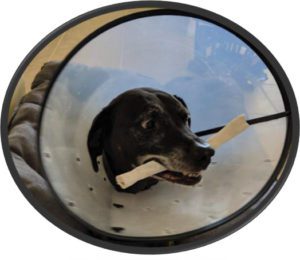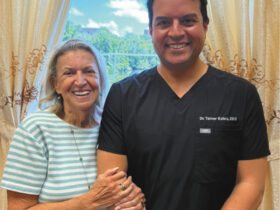By Blake W. Kirkpatrick
 A few years ago, in this same publication, this author wrote on the concept of lifetime gifts to family members (that often go unreported) and issues one might want to consider before making gifts in the future.1 Our dog was the inspiration behind that article and is again today.
A few years ago, in this same publication, this author wrote on the concept of lifetime gifts to family members (that often go unreported) and issues one might want to consider before making gifts in the future.1 Our dog was the inspiration behind that article and is again today.
Fast forward to today and the dog is a little older, and, most recently, has developed a few hot spots on his hind quarter, leg, etc. Here is the problem in a nutshell:
hot spot → chewing by the dog → larger hot spot → even more chewing → even larger hot spot → incessant chewing….
Countless bandages, gauze, various hot spot sprays, chew toys and rawhide bone distractions…
none are a match for the dog who apparently enjoys the taste of dog hair and open wounds mixed with any number of the above. In fact, the dog seems to rise to the challenge. Which brings us to the “CONE.”
Some consider the “CONE” to be cruel and unusual punishment for animals who just can’t seem to stay away from their own self-destructive behavior. Others who use the cone or know about the cone, are aware of its mysterious and effective powers. Admittedly, the cone looks ridiculous and in pet owner circles is also commonly referred to as the “cone of shame” or the “cone of obedience.” However, it really is a useful little aide in helping the dog to properly heal.
With the cone attached and thereafter monitored, the dog cannot reach the area of concern. He can however, still get to his food and water bowls. He still goes out to do his business and the other dogs don’t really seem to care that he is wearing a cone (probably because they have been there before). He still gets his ears scratched and attention from the family (actually, a bit more attention than usual). However, as the nickname indicates, the dog is far more obedient. Even the nudging for people food (which is hard to do with a cone on your head) has dramatically declined.
So, what does this have to do with estate planning, which is usually the focal point of these articles? If you have a future beneficiary that might be going through some difficult issues, or who has some self-destructive tendencies then creating boundaries or limitations through trust planning might be something to consider. But what if your heirs don’t have any issues? Well, our dog wasn’t born with hot spots either. Without going full on into reasons, blame, etc., our dog didn’t necessarily cause the hot spots (sometime animal hot spots arise after a traumatic event, stem from a skin condition, etc. and some/many of these no one can predict). Likewise, the unfolding of events in the lives of our children and grandchildren, etc., can give rise to any number of unforeseen challenges, whether or not they are caused by them directly or outside influences.
My dog is approaching 91…in dog years. Fortunately, he has only had hot spots on rare occasion at different times during his lifetime (and we needed the cone after a surgery once). We had no idea exactly when and if these issues would arise. If and when the dog has “issues” the cone goes on, when not, the dog is given more freedom. But our dog is smart. He knows the cone is there even if he isn’t wearing it (usually it hangs next to his food dish when it isn’t on).
Ultimately, we are serving as the “trustees” of the cone. If the dog was able to control the cone, do you think he would wear it? By analogy, the selection of the trustee is an important one, especially since trusts are most often established for heirs when you are not around to control them or cannot for legal or tax purposes. A cone is best affective when applied as needed (without wavering) but with love and compassion. So too are the provisions of a trust. And just because assets are in a trust doesn’t mean the beneficiary will never receive any benefits from the trust (recall that the dog can still get to his food bowl and water dish even with the cone on).
Rushing in and picking a cone off the shelf at the local pet store can be a bad idea too. We had gone through quite a few until we found one that worked and, even then, only after seeing a veterinarian. Having the guidance of a trained vet makes sense, especially if there might be a far more serious problem that needs to be addressed on the dog (like a cyst or skin cancer, etc.). Likewise, having the personal guidance of an attorney to assist with the drafting of the trust is going to serve your intentions far better than pulling a trust document or Will off the shelf at the local office supply store or website.
In short, we love our dog, thus we make sure we have a cone available to put on from time to time, so he doesn’t chew holes in his body. Creating trusts for your children, grandchildren or other heirs should not be seen as cruel or even punishment, but if done right could very well be seen as an act of love.
This Article does not constitute legal advice and may not be relied upon as such. Each individual’s facts and circumstances are different. If you have any questions regarding your particular situation, please consult with legal counsel.
Blake W. Kirkpatrick is a Florida Bar Board Certified Wills, Trust & Estates attorney with the law firm of Wood, Buckel & Carmichael, PLLC. Blake’s practice is concentrated in the areas of estate and tax planning, charitable planning, business succession planning, and estate and trust administration.
Wood, Buckel & Carmichael, PLLC
239.552.4100
www.wbclawyers.com
1 Under the Table: https://swfhealthandwellness.com/table/









